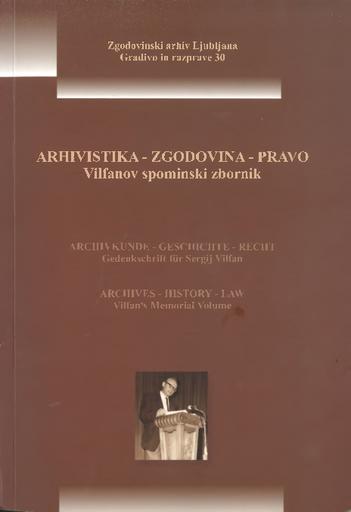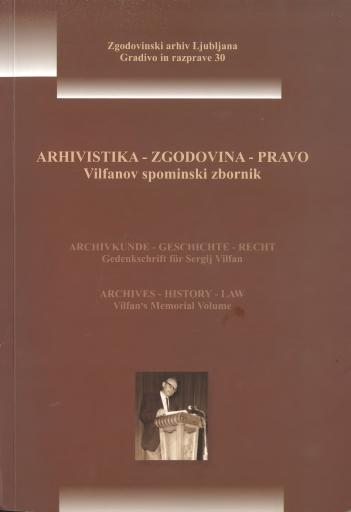/
Literatura
/
Monografije
Sergij Vilfan in pravotvornost Slovencev

Avtor(ji):Vladimir Simič
Soavtor(ji):Nataša Budna Kodrič (ur.), Tatjana Šenk (ur.), Magda Lojk (lekt.), Doris Debenjak (prev.), mag. Niko Hudelja (prev.), Katarina Kambič (prev.), Martin Cregeen (prev.), Tatjana Rodošek (foto.)
Leto:2007
Založnik(i):Zgodovinski arhiv Ljubljana, Ljubljana
Jezik(i):slovenščina, angleščina
Vrst(e) gradiva:besedilo
Zbirk(e):Gradivo in razprave : 30
Avtorske pravice:

To delo avtorja Vladimir Simič je ponujeno pod Creative Commons Priznanje avtorstva-Nekomercialno-Brez predelav 4.0 Mednarodna
Datoteke (1)

Ime:arhivistika_zgodovina_pravo1.pdf
Velikost:26.99MB
Format:application/pdf
Stalna povezava:https://hdl.handle.net/11686/file25390
Opis
Naslov zadnje knjige akademika Sergija Vilfana je bil Zgodovinska pravotvornost in Slovenci. Z izrazom pravotvornost je avtor razumel sposobnost ustvarjati pravo, kar je jasno vidno iz naslova povzetka v nemščini Die historische Fähigkeit zur Rechtsbildung und Slowenen.
Zadnja knjiga je bila zanj še posebno pomembna, ker je hotel v njej podati sintezo svojih raziskav in idej o slovenski pravni zgodovini. Nova sinteza se mu je zdela potrebna v luči novih dogodkov, povezanih z osamosvojitvijo Slovenije.
Metapodatki (12)
- identifikatorhttps://hdl.handle.net/11686/41404
- naslov
- Sergij Vilfan in pravotvornost Slovencev
- Sergij Vilfan and the Law Tormation of Slovenes
- ustvarjalec
- Vladimir Simič
- soavtor
- Nataša Budna Kodrič (ur.)
- Tatjana Šenk (ur.)
- Magda Lojk (lekt.)
- Doris Debenjak (prev.)
- mag. Niko Hudelja (prev.)
- Katarina Kambič (prev.)
- Martin Cregeen (prev.)
- Tatjana Rodošek (foto.)
- opis
- Vilfan's last book »Historical Formation of Law and the Slovenes« was particularly important to him because he wanted to synthesize his research and ideas about Slovene legal history which needed different stress after the creation of the independent state of Slovenians in 1991. I learned how important this work was for him in my last conversation with him sometime at the beginning of 1996. He was already very ill and told me without complaint that he thought out every move he made in advance, in order to avoid the pain. However, the effort to finish the book drove him in his resistance to the fatal illness. He wrote what he was most interested in saying but died before he had time to polish it or better to weld the chapters, as he would have done if he had had the time. He said in the introduction to the book that he feit something was missing in his Slovene Legal History immediately after having it finished in 1961. Whereas there was no doubt that one could speak about Slovene law and therefore Slovene legal history, as about the law by which the Slovenes were governed, there was very little evidence tbat the Slovenes made their own law. Until 1991, the territory of present Slovenia was part of various States and for most of this time the powers outside this territory made most of the law that applied on Slovene territory with little or no influence of the people for whom it was created. It is therefore no wonder that he begins with the question of the relation between laW and the state, in which he explains how political thinking and a positivist view of law as a product of the state as it was conceived in the 19th Century, the Century of codification, influenced the belief that peoples without States had no law or had to have law coming from outside. He connected it to the pessimistic Interpretation of the line of Slovene history, according to which the Slovenes were under the authority of others throughout their past. This resulted in the myth of Slovene servility, which he resented and considered entirely wrong. Vilfan caricatured this myth to the extent that he claimed that even an ordinary but educated Slovene would rather have in addition to his name — »servant« printed on his visiting card. The line of discussion continues to an assessment of the influence of the historical school of law, which still influences much of the research of legal history, although it ran now be seen that it is ever less legal historians who do so, but rather authors who provide historical introductions when writing about modern law. The importance of this school has nevertheless been enormous in the development of methods and bringing new sources under scrutiny. This chapter is a short history of Slovene historical legal research, in which much attention is paid to Metod Dolenc, the man who wrote the first Slovene legal history, entided The Legal History of the Slovene Territory. The following chapters deal with objects related to the legal side of everyday life, which are important sources for legal anthropology, especially the part that is called legal archaeology in German. He begins with a theoretical consideration of the nature and scope of these sources and then lists examples of these objects, such as meeting places, boundary signs and tallies and their use among the Slovenes. Since he knew well that their use was pretty much the same elsewhere, his conclusion was that need was the main source of invention rather then foreign influence. Since they were mainly instruments of an illiterate society, he refused to accept the explanation that similarities were always due to Germanic influences, by saying that the Germans cannot claim a monopoly on illiteracy. After a long chapter on customary law, with some examples from Slovene history, he takes closer look at the circumstances that facilitated the development of customary law, with plenty of cases from the life of village communities, where it appears that their autonomous position favoured the use of customary law. What was left to the community to decide depended to a large extent on how much land was in common use, which in turn depended on the importance of cattle in the economy of the community. The common use of land was the main topič of peasant assemblies but such assembbes often continued to make decisions also about other aspects of corntnunih life and acted as simple courts ruling on disputes in property cases and eve contracts, although far less in criminal cases. Family law is presented through rich marriage rituals, which are dosely connected with the role of women in the farnily and property arrangements between the spouses and often their families. Ali the cases show that simple peasants were quite able to regulate their simple legal relations without much fuss and that they could be very inventive in doing that. A nice example of that was a custom that also gives an interesting insight into the supposedly biggest value among Slovenes: honesty. A village community used to drive the cattle to summer pastures in the mountains, where a herdsman hired by the community made cheese. This cheese was divided according to the quantity of milk given by the cows of a respective owner. The quantity was established by milking on the morning when the catde were driven to the mountains. To prevent abuses, neighbours milked each other's cows on the previous night. As I said, his last book was a synthesis and partial restatement of his entire scientific work. Vilfan wrote texts of various length about Slovene customary law throughout his entire scientific career, so it is no surprise that one such work can be found right at the beginning of his research in 1944. On the initiative of his professor Janko Polec, who felt no inclination for this kind of research, he wrote the section on legal anthropology for the Slovene reassessment of anthropologic research Narodopisje Slovencev. Knowing that he only finished his legal studies in 1941 and became a doctor of law the following year, it can be seen that his talents were recognised very early. He was born in 1919 and due to various positions held by his father, who was employed with the Danube Commission, he attended school in Bratislava, Vienna, Dubrovnik and Ljubljana. A good side of this was his knowledge of several languages, which was very useful in his international career. He studied law in Ljubljana and proved his talent by writing two papers, which received the highest prize of St. Sava. One of them was already in the field of legal history. It was a study about provincial estates and he later returned to that subject several dmeš. As a young lawyer, he began his career as a trainee in the chambers of a counsellor and then as an intern at the Alliance of Industrial Entrepreneurs in Ljubljana. He never mentioned to me the problems he had immediately after the war but Professor Ferenc has told me that he found his name on the list of people imprisoned in 1945. This may have been because he was active in a group of catholic students, Zarja, or that publication of some articles during the war was considered a breach of the cultural silence imposed by the Liberation Front. He was supposed to succeed Professor Janko Polec, who was in trouble himself and was eventually expelled from the university. This was a tremendous shame, since Polec was in the front rank of tbose who made the greatest efforts in order to found the first Slovene University in Ljubljana- ...... Between 1945 and 1950 Vilfan was employed as a lawyer in local administration. He then became director of the Municipal Archive in Ljubljana. It was for this reason tbat Vilfan turned to studies in the field of archivology and the history of cities. He contributed important works in both fields and our colleagues from the archives will therefore assess his role as an archivist. His work was recognised by his peers abroad; Le was a reporter at several Conferences and presided over the international commission for the history of cities. Vilfan ftnished his first major work, The Legal History of the Slovenes, by 1961. He received for it the highest prize for scientific work that was at that time given in the Republic of Slovenia. It still remains the basic work in the field. Unfortunately, he did not have time to prepare a new revised edition and in the nineties refused a simple reprint arguing that more time has passed from the first edition than between the history written by Dolenc and his own. The book was only reprinted after his death. The Legal History of the Slovenes was adapted by Vilfan for a German edition in 1968. It was smaller in size, since many facts that were general in legal history could be omitted, but the bibliography was updated. The lack of time for a new edition of his legal history can be explained by the enormous amount of research he did instead, of which only the main works can be mentioned here. It was the Beigrade Professor Jorjo Tadič who introduced Vilfan to scientists abroad and opened the doors for him by getting him a grant to study or six months in Paris at Ecole pratique des Hautes Emdes in the section led by Fernand Braudel. He was able to gain an insight here into the literature he was lacking in the modest Situation in Ljubljana. It gave rise to his interesi in economic history and he wrote some basic Slovene works in this field, particularly about the history of prices, taxation and money. By that tirne he was already a member of the small group of Slovene historians who prepared a Slovene economic and social history for the Slovenian Academy of Sciences and Arts. In the first volume, on Agrarian History, his contribution was smaller but he wrote more than half of the second volume, which came out in 1980.1 would highlight two of the chapters he wrote because they represent the best Slovene presentation of the feudal legal systém. The chapter about manors presents the administrative side of feudalism, in which manors are the basic Organisation of government, while the chapter on property rights shows the economic side of the complex systém of tenancies. I must of course stress that the scope of all of his studies in the volume goes far beyond feudalism. Prior to that, Vilfan re-established his Connection with the law faculty. In the fifties his Cooperation had been as an examiner but in 1970 he became a full Professor at the faculty. His colleague Bogo Grafenauer wrote that it was a shame for the faculty that it only invited him at that time but the fact that he started as a full professor proved that this was recognized. He was never elected dean of the facuk because he had neither the time nor the interest in holding this post but he played important role as chairman of the commission that decided the curriculum and ad mission criteria in the period of great changes in the systém of education. As a teacher, Vilfan was faced with the problem that there was no textbook for legal history because he thought that his Legal History of the Slovenes was too voluminous for an ordinary student. He solved the problem by issuing study notes but in 1990 wrote a short Introduction to Legal History, which stili remains the rnain textbook. As a reference book one cannot omit his Jugoslawien, which appeared in 1988 in the third volume of Hanbuch der Quellen und Literatur der neueren europäischen Privatrechtgeschichte, edited by Helmut Coing. It contains the basic bibliography with short historical introductions. In the seventies and eighties Vilfan was also active in other fields. One of the most important of his contributions was about legal language as it developed in the Haps- burg Empire. He was the author of a chapter and the introduction and the editor of a volume Comparative Studies on Governments and Non-dominant Ethnie Groups in Europe 1850-1940, which came out in 1993. He paid a great deal of attention to another topic that he studied throughout his entire career, the role of estates. He published several articles in different languages, which dealt with different aspects of the history of estates. His main concern was the estates of Carniola the central Slovene province and in particular the relation between financing the military border, its economic impact and the fading role of the estates. This brings us to the point at which it can be mentioned how this enormous and intelligent work was recognized. In 1978 he became an associate member and five years later a full member of the Slovenian Academy of Sciences and Arts. This was followed by a real shower of honours: in 1987 a corresponding member of the Polish Academy, in 1988 a corresponding member of the Austrian Academy and in 1989 a corresponding member of the European Academy. One side of the personality has been presented through the work of Professor Vilfan. It needs to be said that he was tall man, whose face looked severe because of his spectacles but this changed when his kindly smile appeared and his behaviour was always in accordance with his kind nature. He never raised his voice, even when he was confronted with utter inventions of ignorance during examinations, which took too much of his precious time. His lectures were straight to the point but never boring because he knew how to choose the presented facts with wit, and his sense of humour was always there. I do not think that he would háve labelled himself a philosopher, but in the sense of a good man he was certainly that. He knew how to inspire students to give their best at an examination and was a mild examiner, although that doesn't mean he was undemanding. As an Illustration of how he wanted to transform a student into a thinking intellectual, let me quote one of his questions: »Why is a symbol of the »Slovene« state that is now in Austria, shown on the first Slovenian money? Arguments for and against.« That he was a gentelman is best shown by his attitude when there was a question of whetrher an exam passed at another faculty under another professor should be recognized when a student changed the school. He couls lightly say that if he passed the examination of that professor, he must have known more than he would have needed to pass mine. Let me finish with a quotation from colleague Kranjc: »Professor Vilfan has become history.« In vernacular this is not the best ending but I trust that this audience will inderstand it correctly.
- založnik
- Zgodovinski arhiv Ljubljana
- zbirka
- Gradivo in razprave : 30
- datum
- 2007
- 01. 01. 2007
- tip
- besedilo
- jezik
- Slovenščina
- Angleščina
- jeDelOd
- pravice
- licenca: ccByNcNd
